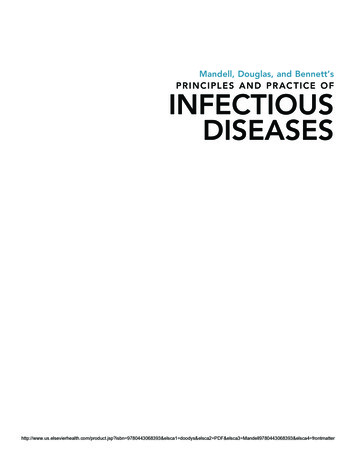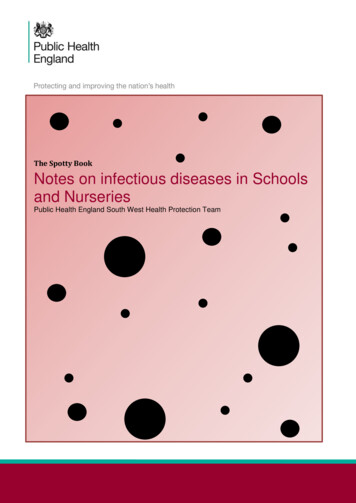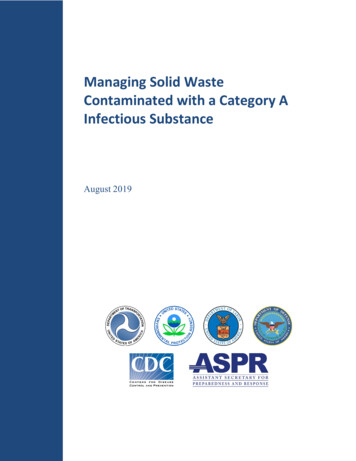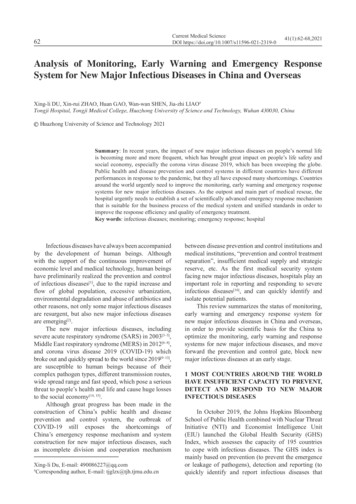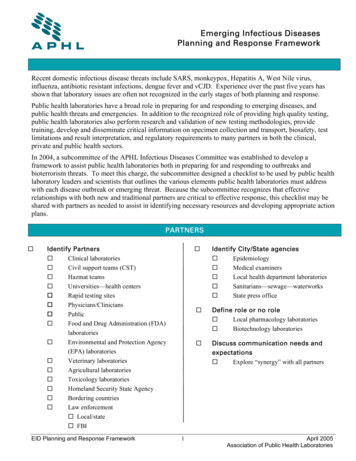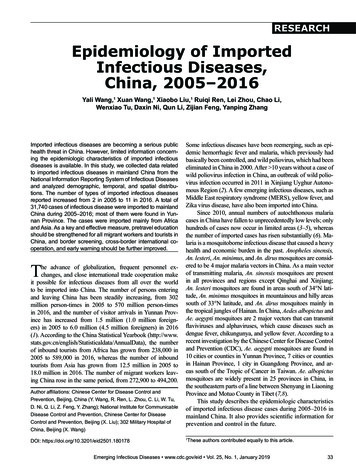
Transcription
RESEARCHEpidemiology of ImportedInfectious Diseases,China, 2005–2016Yali Wang,1 Xuan Wang,1 Xiaobo Liu,1 Ruiqi Ren, Lei Zhou, Chao Li,Wenxiao Tu, Daxin Ni, Qun Li, Zijian Feng, Yanping ZhangImported infectious diseases are becoming a serious publichealth threat in China. However, limited information concerning the epidemiologic characteristics of imported infectiousdiseases is available. In this study, we collected data relatedto imported infectious diseases in mainland China from theNational Information Reporting System of Infectious Diseasesand analyzed demographic, temporal, and spatial distributions. The number of types of imported infectious diseasesreported increased from 2 in 2005 to 11 in 2016. A total of31,740 cases of infectious disease were imported to mainlandChina during 2005–2016; most of them were found in Yunnan Province. The cases were imported mainly from Africaand Asia. As a key and effective measure, pretravel educationshould be strengthened for all migrant workers and tourists inChina, and border screening, cross-border international cooperation, and early warning should be further improved.The advance of globalization, frequent personnel exchanges, and close international trade cooperation makeit possible for infectious diseases from all over the worldto be imported into China. The number of persons enteringand leaving China has been steadily increasing, from 302million person-times in 2005 to 570 million person-timesin 2016, and the number of visitor arrivals in Yunnan Province has increased from 1.5 million (1.0 million foreigners) in 2005 to 6.0 million (4.5 million foreigners) in 2016(1). According to the China Statistical Yearbook nnualData), the numberof inbound tourists from Africa has grown from 238,000 in2005 to 589,000 in 2016, whereas the number of inboundtourists from Asia has grown from 12.5 million in 2005 to18.0 million in 2016. The number of migrant workers leaving China rose in the same period, from 272,900 to 494,200.Author affiliations: Chinese Center for Disease Control andPrevention, Beijing, China (Y. Wang, R. Ren, L. Zhou, C. Li, W. Tu,D. Ni, Q. Li, Z. Feng, Y. Zhang); National Institute for CommunicableDisease Control and Prevention, Chinese Center for DiseaseControl and Prevention, Beijing (X. Liu); 302 Military Hospital ofChina, Beijing (X. Wang)DOI: https://doi.org/10.3201/eid2501.180178Some infectious diseases have been reemerging, such as epidemic hemorrhagic fever and malaria, which previously hadbasically been controlled, and wild poliovirus, which had beeneliminated in China in 2000. After 10 years without a case ofwild poliovirus infection in China, an outbreak of wild poliovirus infection occurred in 2011 in Xinjiang Uyghur Autonomous Region (2). A few emerging infectious diseases, such asMiddle East respiratory syndrome (MERS), yellow fever, andZika virus disease, have also been imported into China.Since 2010, annual numbers of autochthonous malariacases in China have fallen to unprecedentedly low levels; onlyhundreds of cases now occur in limited areas (3–5), whereasthe number of imported cases has risen substantially (6). Malaria is a mosquitoborne infectious disease that caused a heavyhealth and economic burden in the past. Anopheles sinensis,An. lesteri, An. minimus, and An. dirus mosquitoes are considered to be 4 major malaria vectors in China. As a main vectorof transmitting malaria, An. sinensis mosquitoes are presentin all provinces and regions except Qinghai and Xinjiang;An. lesteri mosquitoes are found in areas south of 34 N latitude, An. minimus mosquitoes in mountainous and hilly areassouth of 33 N latitude, and An. dirus mosquitoes mainly inthe tropical jungles of Hainan. In China, Aedes albopictus andAe. aegypti mosquitoes are 2 major vectors that can transmitflaviviruses and alphaviruses, which cause diseases such asdengue fever, chikungunya, and yellow fever. According to arecent investigation by the Chinese Center for Disease Controland Prevention (CDC), Ae. aegypti mosquitoes are found in10 cities or counties in Yunnan Province, 7 cities or countiesin Hainan Province, 1 city in Guangdong Province, and areas south of the Tropic of Cancer in Taiwan. Ae. albopictusmosquitoes are widely present in 25 provinces in China, inthe southeastern parts of a line between Shenyang in LiaoningProvince and Motuo County in Tibet (7,8).This study describes the epidemiologic characteristicsof imported infectious disease cases during 2005–2016 inmainland China. It also provides scientific information forprevention and control in the future.1These authors contributed equally to this article.Emerging Infectious Diseases www.cdc.gov/eid Vol. 25, No. 1, January 201933
RESEARCHMaterials and MethodsSurveillance SystemIn China, since the establishment in the 1950s of the Notifiable Disease Reporting System (NDRS), which was themain communicable disease surveillance system, manydisease-specific surveillance systems have been developedas complements to NDRS. In 2004, the National Information Reporting System of Infectious Diseases, an internet-based real-time information reporting technique, wasintegrated into NDRS to improve case-based reporting.The workflow includes data collection, data management,data use, and report dissemination. Once a case of notifiable infectious disease or emerging infectious disease isidentified, it is mandatory for doctors in all hospitals andclinics to report to the network within the statutory period.CDCs at various levels (e.g., provincial) are in charge ofdata checking, utilization, and timely information feedback by uploading the reports on the websites. All thehospitals and CDCs at different levels can download thesereports and know the national status in a timely manner,which makes the epidemic information transparent. Thecompleteness and timeliness of case reporting have improved dramatically since 2004 (9). Therefore, this studytakes 2005 as the first year of analysis, considering dataquality and stability.Once an emerging infectious disease is found that isnot yet included in statutory reporting but is of considerable interest, the National Health Commission of thePeople’s Republic of China usually organizes relevant experts in clinical, epidemiologic, etiologic, and other areasto assess its risk of becoming epidemic, spreading range,influence extent, and social burden to determine whetherthe disease should be added to the list of notifiable infectious diseases. The results are submitted to the NationalPeople’s Congress for deliberation and adoption. At thesame time, the emerging infectious disease is requiredto be reported under “other categories of infectious diseases” in the National Information Reporting System ofInfectious Diseases.Data CollectionUsing data from the National Information Reporting System of Infectious Diseases (which does not include HongKong, Macao, and Taiwan), we performed a retrospectiveanalysis of imported infectious diseases in mainland Chinaduring January 1, 2005–December 31, 2016. We selecteddata according to reporting date, reporting area, and finalconfirmation. The cases reported in the National Information Reporting System of Infectious Diseases, includinglaboratory-confirmed cases and clinically diagnosed cases,were diagnosed by clinicians according to the unified national diagnostic criteria (10).34Population and Case DefinitionWe divided the population into citizens of China and foreign citizens according to their native countries, so the imported cases included not only citizens of China returningfrom migrant work or other travel abroad but also foreignvisitors, expatriates, and migrant workers in China. Themajor occupational categories of patients were migrantworkers, doctors, teachers, students, and retirees.Local CDC staff ascertained a potential imported caseaccording to the field investigation results after diagnosis.A case in a patient who had visited or lived in an endemicor epidemic area outside China within the longest incubation period before the date of onset was classified as animported case. Conversely, a case would be classified asa domestic case if there was no evidence of an infectionacquired abroad.Statistical AnalysisWe entered and managed the data using Microsoft Excel2010 (https://office.microsoft.com/excel). We used SPSS18.0 tware) to describe characteristics of imported infectiousdiseases regarding geographic and temporal distribution,gender, age, region, or country of origin. We created distribution maps of imported cases using ArcGIS 10.3 (http://www.arcgis.com).ResultsDuring 2005–2016, a total of 31,740 cases of infectiousdiseases were imported into China. These included 27,497cases of malaria, 3,351 cases of dengue fever, 773 cases ofinfluenza A(H1N1), 24 cases of Zika virus disease, 18 cases of chikungunya fever, 11 cases of yellow fever, 2 casesof acute flaccid paralysis caused by poliomyelitis, 1 caseof MERS, and 65 cases of other infectious diseases (Table1). The study revealed that Yunnan Province witnessed thelargest number of imported cases of infectious diseasesduring the study period.Epidemiologic Profile of Imported Cases inMainland China, 2005–2016Demographic Characteristics of Imported CasesMost persons with imported cases were male. The median age of patients with imported cases of malaria was39 years; of patients with dengue fever, 32 years; and ofinfluenza A(H1N1), 20 years (Table 2; Figure 1). Amongthese imported cases, 2,470 were reported in foreigners and29,270 in travelers from China; 18,932 cases were reportedin migrant workers from China and 12,808 in persons withother occupations. Migrant workers from China accountedfor 65.2% of imported malaria cases and 28.1% of imported dengue fever cases.Emerging Infectious Diseases www.cdc.gov/eid Vol. 25, No. 1, January 2019
Epidemiology of Imported Diseases, ChinaTable 1. Imported infectious diseases in mainland China, 2005–2016*Indigenous um vivax149,67510,506160,181P. falciparum8,08014,89622,976Undetermined speciesSubtotalDengue feverInfluenza A(H1N1)ChikungunyaLyme diseaseEHFScrub low feverZika virusTotalImportedcases, %Main reportingprovinces/citiesMain location(s)of acquisition6.664.8YunnanYunnan, GuangxiNANAYunnanBeijing, GuangdongGuangdong, ZhejiangBeijingNAHubeiHubei, SichuanNANABeijing, GuangdongAsia (Myanmar)Asia (Myanmar), Africa(Ghana)NANAAsia (Myanmar)Asia, USAAngola, PhilippinesGermanyNAThailandAfghanistan, SpainNANACameroon, Congo,GabonThailandCongoNigeriaSouth KoreaAfrica (Angola)South 00.0100.0470,17231,740501,9116.3*AFP, acute flaccid paralysis; CCHF, Crimean-Congo hemorrhagic fever; EHEC, Escherichia coli O157:H7; EHF, epidemic hemorrhagic fever; JE,Japanese encephalitis; MERS, Middle East respiratory syndrome; NA, not applicable; VL, visceral leishmaniasisTrends in Imported Cases in Mainland China, 2005–2016In 2005, only 2 types of imported infectious diseases werereported in mainland China: malaria and dengue fever. Chikungunya was imported into China in 2008 and influenzaA(H1N1) in 2009; Lyme disease has been imported since2012. Since 2013, the number of types of imported infectiousdiseases reported has increased each year. A total of 6 typesof diseases, including scrub typhus, visceral leishmaniasis(VL), Japanese encephalitis (JE), epidemic hemorrhagicfever, loiasis, and Crimean-Congo hemorrhagic fever,started to be imported in 2013. Imported cases of Escherichia coli O157:H7 infection, schistosomiasis, and MERSTable 2. Demographic characteristics of persons with imported cases of infectious disease in mainland China, 2005–2016*Sex, no. (%)Native country, no. (%)Occupation, no. (%)Mean age, ia25,8191,67839 (1–83)26,048 (94.7) 1,449 (5.3)17,9299,568 (34.8)(93.9)(6.1)(65.2)Dengue fever2,138 (63.8)1,21332 (1–86)2,403 (71.7)948 (28.3)943 (28.1)2,408 (71.9)(36.2)Influenza758 (98.1)15 (1.9)20 (0.7–75)731 (94.6)42 (5.4)15 (1.9)758 (98.1)A(H1N1)Chikungunya15 (83.3)3 (16.7)25 (20–47)15 (83.3)3 (16.7)4 (22.2)14 (77.8)Lyme disease11NA1102Scrub typhus3 (42.9)4 (57.1)23 (3–42)2 (28.6)5 (71.4)07VL13 (92.9)1 (7.1)34 (25–49)14 (100.0)0 (0.0)13 (92.9)1 (7.1)JE12 (70.6)5 (29.4)8 (1–54)5 (29.4)12 (70.6)017EHF7 (100.0)048 (25–71)6 (85.7)1 (14.3)5 (71.4)2 (28.6)AFP02NA2002Loiasis10 (90.9)1 (9.1)37 (22–60)11 (100.0)0 (0.0)8 (72.7)3 (27.3)EHEC3063 RS10430101Yellow fever8 (72.7)3 (27.3)42 (18–53)11 (100.0)0 (0.0)8 (72.7)3 (27.3)Zika virus15 (62.5)9 (37.5)30 (5–55)16 (66.7)8 (33.3)7 (29.2)17 (70.8)Total28,8052,935NA29,270 (92.2) 2,470 73,3517731827141772113111112431,740*AFP, acute flaccid paralysis; CCHF, Crimean-Congo hemorrhagic fever; EHEC, Escherichia coli O157:H7; EHF, epidemic hemorrhagic fever; JE,Japanese encephalitis; MERS, Middle East respiratory syndrome; NA, not applicable; VL, visceral leishmaniasisEmerging Infectious Diseases www.cdc.gov/eid Vol. 25, No. 1, January 201935
RESEARCHaround major festival events, such as the Spring Festival(celebrating the lunar new year), May Day, the Mid-Autumn Festival, and the National Day (October 1) (11).Spatial Distribution of Imported DiseasesProvinces with Imported Diseaseswere reported in 2015. In 2016, 24 cases of Zika and 11cases of yellow fever were imported. The types of reportedimported infectious diseases increased dramatically after2013 and reached 11 types in 2016, compared with only 2types in 2005.We found that imported cases of malaria showed anupward trend from 2005 to 2016. The imported cases ofdengue fever increased year by year; increased sharply in2013 and 2015, with a peak in 2015 (1,094 cases); and declined slightly in 2016 (Figure 2).All 31 provinces across the country reported imported malaria (Figure 4); 36.1% (9,931 cases) were reported in Yunnan Province. The number of imported malaria cases in Yunnan Province was generally decreasing, however, whereas ithad been slowly increasing in Sichuan, Henan, Jiangsu, andZhejiang Provinces and other southeastern provinces year byyear. In 2013, imported malaria increased sharply in GuangxiProvince, which had the largest number of imported malariacases in China for that year (1,261/4,067; 31.0%), accounting for 52.7% (1,261/2,394) of the total imported malariacases in this province during 2005–2016 (data not shown).Twenty-seven provinces across the country, all exceptShanxi, Qinghai, Ningxia, and Tibet, reported dengue feverduring 2005–2016. Among all imported dengue fever cases, 42.9% (1,439/3,351) were reported in Yunnan Province(data not shown). Influenza A(H1N1) was imported mainlyinto Beijing, Guangdong, and other major port cities (datanot shown).Seasonal Distribution of Imported CasesOrigin Region/Country of Imported DiseasesFigure 1. Distribution by age group of imported malaria, denguefever, and influenza A(H1N1) cases in mainland China, 2005–2016.Many of the main imported diseases in mainland China exhibited seasonality. Most yellow fever cases were importedin March. There was usually a higher incidence of importedmalaria during April–August, reaching a peak in May andJune. All the JE cases were imported during June–September, whereas incidence of imported dengue fever usuallypeaked in October (Figure 3). In particular, the cases ofZika were imported mainly through international airportsAccording to our analysis, Africa and Asia were the main regions of origin of imported cases; 15,021 (47.3%) patientscame from Africa and 12,581 (39.6%) from Asia (Figure 5).Asia was the main origin of imported dengue fever (3,097cases, 92.4%), chikungunya, VL, JE, and other diseases. Africa was the main region of origin for imported malaria (14,854cases, 54.0%), and others, especially Plasmodium falciparum,yellow fever, loiasis, and other diseases (Table 3).Figure 2. Annual number ofimported malaria, dengue fever,and influenza A(H1N1) cases inmainland China, 2005–2016.36Emerging Infectious Diseases www.cdc.gov/eid Vol. 25, No. 1, January 2019
Epidemiology of Imported Diseases, ChinaFigure 3. Monthly distribution ofimported malaria, dengue fever,and influenza A(H1N1) cases inmainland China, 2005–2016.Myanmar was the main country of origin for 5 imported diseases. These diseases were malaria (7,888 cases,28.7%), dengue fever (1,384 cases, 41.3%), scrub typhus(6 cases, 85.7%), JE (13 cases, 76.5%), and acute flaccidparalysis (2 cases, 100.0%) (additional data not shown).Malaria was imported mainly from Africa (14,854cases, 54.0%) and Asia (9,160 cases, 33.3%). P. vivaxcame mainly from Asia, especially Myanmar (peaked in2011), and was introduced into Yunnan Province during2005–2016. There was an exception, however: Ghana exported more cases of P. vivax malaria to China in 2013.After that introduction, the number of imported cases ofP. vivax malaria from Ethiopia, Angola, Equatorial Guinea,and other countries in Africa began to increase slightly. P.falciparum malaria also came mainly from Asia, especiallyfrom Myanmar, which exported it into Yunnan Provinceuntil 2013. In 2013, the largest number of cases of P. falciparum malaria came from Ghana; thereafter, most caseswere imported from Angola, Nigeria, Equatorial Guinea,Ghana, and other countries in Africa, mainly into Guangxi,Jiangsu, and other southeastern provinces in China (datanot shown).Imported dengue fever cases were mainly from Asia,especially from Myanmar; most of them were brought intoFigure 4. Number of cases ofimported infectious diseases inmainland China, by province,2005–2016.Emerging Infectious Diseases www.cdc.gov/eid Vol. 25, No. 1, January 201937
RESEARCHFigure 5. Number of cases ofinfectious diseases exported tomainland China, by country oforigin, 2005–2016.Yunnan and Guangdong Provinces. Influenza A(H1N1)was imported mainly from the United States (141 cases,18.2%) and Australia (111 cases, 14.4%). The 1 caseof MERS was imported from South Korea in 2015. All11 imported cases of yellow fever came from Angola.Of the 24 imported Zika cases, 70.8% (17 cases) werefrom Venezuela.DiscussionMany infectious diseases, such as P. vivax malaria, denguefever, influenza A(H1N1), epidemic hemorrhagic fever,JE, chikungunya, Lyme disease, scrub typhus, and VL, arefound frequently in the indigenous population of China, butsome are found more often as imported diseases, such as P.falciparum malaria, yellow fever, Zika virus, and MERS.Imported P. falciparum malaria is a major obstacle toachieving malaria elimination in China (12–14). This studyshowed that malaria was the most frequent imported infectious disease during 2005–2016, and Yunnan was the province with the greatest number of cases of imported malaria,which was consistent with other relevant studies in China(15–17). The reason for the large number of imported casesis that Yunnan Province has long international borders withMyanmar, Laos, Vietnam, and other countries of the Greater Mekong Subregion that show a high incidence of malaria(16). The persons who cross these borders to enter or leaveChina increase opportunities for infectious diseases to beimported from adjacent countries (3,14,18,19), especiallyfrom Myanmar (12,13,20).P. falciparum malaria was imported mainly fromGhana and P. vivax malaria mainly from Asia, which wasconsistent with Zhou’s findings (5). The number of casesof P. falciparum malaria imported into Guangxi Provinceincreased significantly in 2013; this increase can be attributed mainly to cases imported from Ghana in 2013, whichwas related to people working in Ghana and other Africacountries during a gold rush in that year (21,22).38Africa and Asia were the main origins of importedmalaria and other mosquitoborne diseases, findings consistent with those of Tian et al. (23). First, as a result ofthe rapid development of international economic exchange,trade, and travel, the number of migrant workers fromChina in Africa and Asia has increased annually in recentyears. Second, climate and sanitary conditions in Africaand Southeast Asia are suitable for mosquitoes. Migrantworkers from China in these areas are engaged mostly inoutdoor field work, and their working and living environments are not mosquito preventive. Therefore, they havegreater risk for infection (24,25). In addition, their healtheducation level and self-protection awareness are low. Allthese factors have resulted in an increased number of malaria and other mosquitoborne diseases (26). Therefore, themain challenges of eliminating P. falciparum malaria arecurtailing border malaria and imported cases from Myanmar and countries in Africa (6,14). Cooperation betweenChina and neighboring countries has played an importantrole in improving malaria control at cross-border areas andshould be further strengthened.This study revealed that imported cases of infectiousdiseases such as malaria, dengue fever, and chikungunyawere more common in male youths, which is consistentwith the findings of Jiao et al. (24). Industries that use laborfrom China generally include construction, manufacturing,and transportation; therefore, the proportion of young menwas high among migrant workers from China, to meet theneeds of these industries.Because of the distributions of mosquitoes and othervectors in China, diseases such as dengue fever, P. vivaxmalaria, JE, epidemic hemorrhagic fever, and chikungunya are acquired primarily locally. However, the numbersand the types of imported infectious diseases reported haveincreased in recent years. We indicate 4 main reasons forthis increase. First, globalization is a major factor. Withgrowing economic globalization, ongoing development ofEmerging Infectious Diseases www.cdc.gov/eid Vol. 25, No. 1, January 2019
Epidemiology of Imported Diseases, ChinaTable 3. Imported infectious diseases in mainland China, by region of origin, ,097446725Influenza A(H1N1)7268122621877Chikungunya2120001Lyme disease000110Scrub 000MERS010000Yellow fever1000000Zika 4973,3517731827141723711111102431,740100*AFP, acute flaccid paralysis; CCHF, Crimean-Congo hemorrhagic fever; EHEC, Escherichia coli O157:H7; EHF, epidemic hemorrhagic fever; JE,Japanese encephalitis; MERS, Middle East respiratory syndrome; VL, visceral leishmaniasis.international trade, and convenient and fast transportationin recent years, factors such as microbial mutation, globalwarming, floods, droughts, and natural migration of animals as disease vectors have increased the risk of diseaseintroduction into China (27–29). Second, these increasesare related to the increases in the number of migrant workers from China, as well as increases in the number of tourists. This study showed that migrant workers from Chinaaccounted for a large proportion of imported malaria. Migrant workers and tourists are more at risk than local residents because of lack of preexisting immunity that dramatically increases the chances that they could become infectedwith these diseases and bring them in from abroad (19).Third, the level of surveillance, diagnosis, and detection ofemerging or reemerging infectious diseases improved inChina during the study years, which potentially contributedto the increase in the number and the types of cases with aconfirmed diagnosis. Finally, some of the increases werecaused by newly discovered or emerging infections, suchas MERS, which was discovered in 2012 and confirmedin 2013; the 1 case imported into China was a result of thelarge outbreak in South Korea in 2015.This study has analyzed the epidemiologic characteristics of all imported infectious diseases in mainland Chinaover a recent 10-year period to provide scientific guidancefor control and prevention of imported diseases in China.The study also has limitations. First, there is currently nospecial reporting system for imported infectious diseases inChina. The imported cases that were analyzed in this studywere reported through the National Information ReportingSystem of Infectious Diseases and identified by local CDCstaff through epidemiologic investigation; therefore, not allimported cases may have been identified. A second limitationis that the data of this study were obtained from the monitoring system and there are few denominator data to usefor calculating the rates of imported infectious diseases, soconclusions are limited and risks cannot be calculated. Finally, the factors concerning imported infectious diseasesare complex, whereas our data are limited. Some demographic characteristics; trip information, such as purposeand duration of travel; and climate, environmental, andother relevant information could not be obtained. In subsequent research, we will focus on the collection of moreinformation and continue to conduct our in-depth study ofimported infectious diseases.To control and prevent imported infectious diseases,we recommend several measures. First, pretravel educationtargeting infectious diseases that are endemic or prevalentin the destination countries is key for the prevention of imported diseases, especially imported malaria. Such education includes pretravel special training sessions; distribution of pamphlets or leaflets; and posttravel tips via notices,banners, or scrolling electronic screens at international entry and exit ports. Also important are dispensing of freepreventive medications for malaria prophylaxis, self-treatment of severe travelers’ diarrhea, and vaccination againstvaccine-preventable diseases such as JE and yellow feverduring international travel and residence (30).Second, border screening should be strengthened andimproved. The effectiveness of border screening is controversial (31), but in recent years, China’s screening practices have proven to be a crucial measure for discoveringimported infectious diseases in travelers who are ill at thetime they cross a border. Screening has played a major rolein prevention as the first line of defense against importation of foreign infectious diseases. For example, among 25Emerging Infectious Diseases www.cdc.gov/eid Vol. 25, No. 1, January 201939
RESEARCHcases of Zika virus disease imported into mainland China in2016, border screening recognized 9 (11), and of 11 casesof imported yellow fever reported in 2016, border screening recognized 6 (32). Border screening should be strengthened and improved to prevent those epidemic diseases andothers from entering China (32–34).Third, as a second line of defense against imported diseases, fever clinics and primary clinicians need to play anactive role in identifying patients with imported infectiousdiseases. At present, many problems exist in fever clinics set up in medical institutions, such as failure to meetrequirements, unqualified procedures, or nonstandardizedmanagement, and some locations may even be out of service. Clearer management standards are needed to providea better chance for infectious disease screening. Training ofmedical staff, especially primary clinicians, should be reinforced to improve the ability to identify, diagnose, and treatemerging or reemerging infectious diseases and to ensurethat imported cases can be diagnosed and control measurescan be implemented as early as possible to prevent thesediseases from further spreading in China.Fourth, multisectoral and regional cooperation mechanisms, especially international cooperation mechanismsin the border areas, should be further enhanced (35). Wesuggest that the relevant departments should intensify cooperation by using well-defined responsibilities and shouldimprove communication regarding all aspects of publicinformation sharing, training, monitoring, and control. Itis critical that, in the border areas, neighboring countriesdevelop the management of persons entering and leaving,improve the control of mosquitoes, and jointly respond toinfectious diseases.Fifth, it is necessary to improve the early warning andresponse capacity for emerging infectious diseases. Werecommend establishing a special system of surveillance,risk assessment, and early warning. Spatiotemporal modelslinking disease data and different environmental factors arealso urgently needed (36).In summary, our study found that the numbers ofemerging infectious diseases imported into China have increased year by year. Therefore, we must pay closer attention to prevention and control of imported cases, while preventing and controlling indigenous cases. These factors arecrucial for preventing and controlling infectious diseases,such as P. falciparum malaria, that have a large number ofimported cases and seriously hinder the process of Chinaeliminating malaria and other diseases.This study was funded by the World Bank Avian/Human Influenza Trust Fund Grant Project of Capacity Building for Emerging Infectious Diseases Control and Prevention in China (grantno. TF012401) and the National Natural Science Foundation ofChina (grant no. 81703280).40About the AuthorDr. Yali Wang is an epidemiologist working at the Public HealthEmergency Center, Chinese Center for Disease Control andPrevention, Beijing, China. Her research interests are preventionand control of emerging infectious diseases.References1.2.3.4.56.7.8.9.10.
Imported infectious diseases are becoming a serious public health threat in China. However, limited information concern-ing the epidemiologic characteristics of imported infectious
